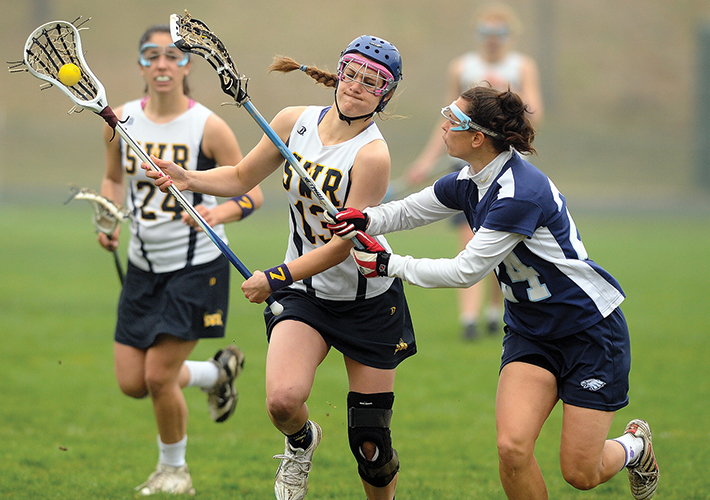
Gearing up for the Game
Standardizing Headgear for Women's Lacrosse
Headgear pictured may not meet the new specification.
The risk of concussions in high impact sports has become a growing concern. When US Lacrosse decided it was time to standardize protective headgear for the women's game, ASTM Committee F08 on Sports Equipment and Facilities was there to help, and development of a new standard (F3137, Specification for Headgear Used in Women's Lacrosse) began.
Men's and women's lacrosse are treated as two distinct sports because of notably different game-time rules, so establishing performance safety standards can be tricky. Full-body contact and collision is allowed in the men's game, which requires players to wear protective headgear. However, intentional stick or body contact is considered illegal in the women's game. Because of this difference, the use of headgear has always been optional for women in rules set by US Lacrosse, the national governing body of the sport in the United States.
Although headgear can be worn in the women's game, the US Lacrosse rules never stated that doing so reduces the risk of head injuries. Ann Carpenetti, vice president of US Lacrosse Operations, voiced concern about possible confusion arising from this, and the need for a specification for headgear worn by female lacrosse players. "Without an evidence-based standard that demonstrates the product was developed and tested to address specific impacts most frequently seen in the game, the benefits and risks to those players wearing headgear are, at best, unknown," says Carpenetti, co-chair of ASTM Subcommittee F08.31 on Women's Lacrosse Equipment.
US Lacrosse prioritized this problem and turned to Subcommittee F08.53 for a solution. Experts from the lacrosse community, the medical field, the biomechanics industry, product testing laboratories and many others collaborated to develop F3137. Their goal was "to create a standard for women's lacrosse headgear that provides an appropriate level of protection, does not increase the risk of injuries to other players, and maintains the rules, culture and traditions of this unique women's sport."
At this time, no rulemaking bodies are planning to mandate the use of F3137 headgear. "The ASTM performance standard was developed to allow for optional use and to ensure that players opting not to wear headgear would not be injured by players who choose to wear protective headgear," says Carpenetti. This may be reevaluated once the women's lacrosse community begins to see F3137-compliant protective headgear in action.
According to the US Lacrosse Sports Science and Safety Committee, the most common injuries in the women's game are caused by stick or ball impacts to the head. While eliminating risk is impossible, F3137 will allow for the development of protective equipment that meets the needs of female lacrosse players. Shock absorption, ball impact absorption and deformation tests are a few of the performance requirements that product manufacturers will need to adhere to. Additionally, the equipment must conform to ASTM standards F1446 (Test Methods for Equipment and Procedures Used in Evaluating the Performance Characteristics of Protective Headgear) and F3077 (Specification for Eye Protectors for Women's Lacrosse).
F3137 will be used primarily as a design standard by product manufacturers. "Because it is new, and unique from any other headgear/helmet standard, an implementation timetable will be required in order to allow for manufacturers to take their designs to production, test and then to market," explains Carpenetti. She expects that helmets meeting the standard may be available for purchase in about 18 months.
"This may be a benchmark moment in the continued evolution of girls' and women's lacrosse, especially as it relates to increased safety for all game participants," says Carpenetti.
Nicole Villegas is a student at Villanova University and ASTM's corporate communications intern for 2015.
 SN Home
SN Home Archive
Archive Advertisers
Advertisers Masthead
Masthead RateCard
RateCard Subscribe
Subscribe Email Editor
Email Editor